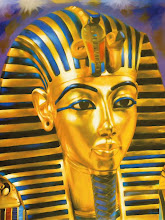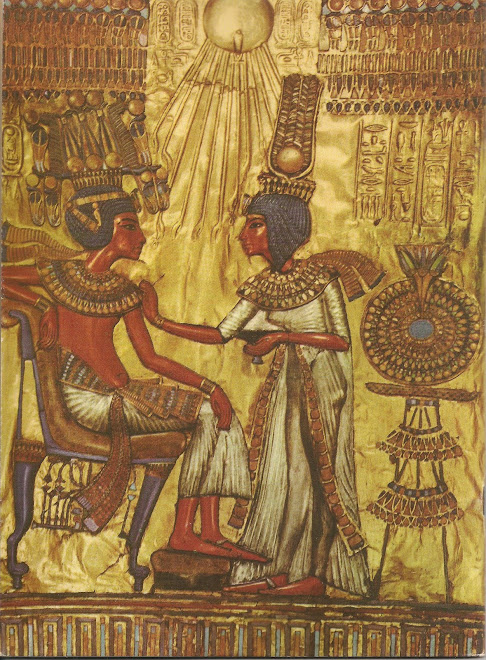domingo, 22 de agosto de 2010
Babalon
Babalon—also known as The Scarlet Woman, The Great Mother, or the Mother of Abominations—is a goddess found in the mystical system of Thelema, which was established in 1904 with English author and occultist Aleister Crowley's writing of The Book of the Law. In her most abstract form, she represents the female sexual impulse and the liberated woman; although she can also be identified with Mother Earth, in her most fertile sense. At the same time, Crowley believed that Babalon had an earthly aspect in the form of a spiritual office, which could be filled by actual women—usually as a counterpart to his own identification as "To Mega Therion" (The Great Beast)—whose duty was then to help manifest the energies of the current Aeon of Horus.
Her consort is Chaos, the "Father of Life" and the male form of the Creative Principle. Babalon is often described as being girt with a sword and riding the Beast. She is often referred to as a sacred whore, and her primary symbol is the Chalice or Graal.
As Crowley wrote in his The Book of Thoth, “She rides astride the Beast; in her left hand she holds the reins, representing the passion which unites them. In her right she holds aloft the cup, the Holy Grail aflame with love and death. In this cup are mingled the elements of the sacrament of the Aeon”.
( extract source - http://en.wikipedia.org/wiki/Babalon )
Babalon related links:
http://www.thelemapedia.org/index.php/Babalon
http://liberbabalon.gydja.com/links.html
http://www.bibliotecapleyades.net/bb/babalon.htm#menu
Marcadores:
aeon of horus,
Babalon,
deities,
magick,
sex magick,
the book of the law,
Thelema_
quinta-feira, 5 de agosto de 2010
Horus & Aeon of Horus
Horus is one of the oldest and most significant deities in the Ancient Egyptian religion, who was worshipped from at least the late Predynastic period through to Greco-Roman times. Different forms of Horus are recorded in history and these are treated as distinct gods by Egyptologists.[1] These various forms may possibly be different perceptions of the same multi-layered deity in which certain attributes or syncretic relationships are emphasised, not necessarily in opposition but complementary to one another, consistent with how the Ancient Egyptians viewed the multiple facets of reality.[2] The earliest recorded form is Horus the Falcon who was the patron deity of Nekhen in Upper Egypt and who is the first known national god, specifically related to the king who in time became to be regarded as a manifestation of Horus in life and Osiris in death.[1] The most commonly encountered family relationship describes Horus as the son of Isis and Osiris but in another tradition Hathor is regarded as his mother and sometimes as his wife.[1] Horus served many functions in the Egyptian pantheon, most notably being the god of the Sky, god of War and god of Protection.
( extract source - http://en.wikipedia.org/wiki/Horus )
Marcadores:
aeon of horus,
ancient egypt,
deities,
Horus_,
magick,
the book of the law,
Thelema_
Maat & Aeon of Maat
Maat, Ma'at, Maāt or Mayet, thought to have been pronounced as *Muʔʕat (Muh-aht),[1] was the Ancient Egyptian concept of truth, balance, order, law, morality, and justice. Maat was also personified as a goddess regulating the stars, seasons, and the actions of both mortals and the deities, who set the order of the universe from chaos at the moment of creation.
The earliest surviving records indicating Maat is the norm for nature and society, in this world and the next, is recorded during the Old Kingdom in pyramid texts (ca. 2780-2250 BCE).[2]
Later, as a goddess in other traditions of the Egyptian pantheon, where most goddesses were paired with a male aspect, her masculine counterpart was Thoth and their attributes are the same. After the rise of Ra they were depicted together in the Solar Barque. As Thoth has been seen to represent the Logos of Plato[3], so Maat has been viewed as an expression of Divine Wisdom.[4]
After her role in creation and continuously preventing the universe from returning to chaos, her primary role in Egyptian mythology dealt with the weighing of souls that took place in the underworld, Duat.[5] Her feather was the measure that determined whether the souls (considered to reside in the heart) of the departed would reach the paradise of afterlife successfully.
Pharaohs are often depicted with the emblems of Maat to emphasise their role in upholding the laws of the Creator.[6]
( extract source - http://en.wikipedia.org/wiki/Maat )
Marcadores:
aeon of maat,
ancient egypt,
deities,
Frater Achad_,
Maat_,
magick,
Thelema_
Subscrever:
Comentários (Atom)




.jpg)
.jpg)











+001.jpg)
+001.jpg)


+001.jpg)





+001.jpg)
+001.jpg)
+001.jpg)

.jpg)



+001.jpg)

+001.jpg)

.jpg)


